Seyed Arash Emrani Zarandi, Mehdi Momeni, Ramin Tabatabaei
Department of Civil Engineering, Islamic Azad University, Kerman Branch, Kerman, Iran
Correspondence to: Mehdi Momeni, Ramin Tabatabaei, Department of Civil Engineering, Islamic Azad University, Kerman Branch, Kerman, Iran.
| Email: |  |
This work is licensed under the Creative Commons Attribution International License (CC BY).
http://creativecommons.org/licenses/by/4.0/

Abstract
Construction due to its situation and required equipment’s is a dangerous job, which every year lots of its workers are hardly injured or even died in whole word. Not only such events result in serious effects on workers and their families’ life, but also effect projects quality and success. Therefore, one of the most important factors which should be considered first in scheduling construction projects is its safety. Our aim in this work is focusing on the safety of construction projects in the city of Kerman. With this aim, a step-by-step statistical analysis is done and some effective parameters are examined to investigate the relationship between safety and construction quality. To measure safety three factors are considered including first-aid and hospitalization injuries, death and changing the job. Information including the overall project cost, the cumulative time, and the completion percentage of projects is also required. Furthermore, for measuring quality which is also called rework, information such as number of defects, cost and workers needed to repairing damages are considered. The data collection method is based on interviewing, questionnaires, field studies and some formulas are used to investigate the relation. Results show that using this model to assess the safety and quality, proves a direct relation between them. It can be proved that by increasing rework, safety risks and injuries are also increased.
Keywords:
Construction quality, Safety, Rework, First-aid injuries, Death injuries
Cite this paper: Seyed Arash Emrani Zarandi, Mehdi Momeni, Ramin Tabatabaei, Relationship between Construction Safety and Foundation Quality Performance, Journal of Civil Engineering Research, Vol. 8 No. 2, 2018, pp. 27-32. doi: 10.5923/j.jce.20180802.02.
1. Introduction
Due to dangers of construction works, lots of researchers and engineers have been widely working to improve safety in distinct projects [1]. Projects’ safety is affected by different factors including the environment conditions, visibility, the weather, and also personal distractions [2]. Moreover, construction equipment is so heavy and risky result in lots of injury risks. Therefore, it is necessary to investigate the relationship between safety and higher-level project characteristics such as between safety and design [3], or safety and project success.The success in any project can be defined by finishing it as it was supposed, by considering damage rate and cost. That means a project is successful when it can be completed without delay, damages and rework beside low cost. This is not possible; therefore, it is important to achieve a good trade-off between these parameters. Another important point that should be considered is some savings may result in extra cost. As an example, some managers try to eliminate or reduce safety budget to decrease the project costs. However, this may result in more cost because of some construction accident, which may hurt some workers. Furthermore, some construction accidents occur before even starting the project, during planning stages. Therefore, to improve safety, scheduling for it should be done from its begging steps. It was also shown that the rate of fatalities could be reduced about 42% if the safe planning and designing is done [4].Satisfying the customer requirements which represents its quality is the other significant parameter in construction, and it is documented through plans, contracts, and standards. Rework is due to not achieving these requirements, so the work should be redone. This rework can be measured by investigating different parameters such as non-conformance, defects, and quality failures. It is obvious more rework results in increasing the project costs and delay. Therefore, as a construction project manager different factors and parameters should be considered together in order to perform a successful project [5, 6].As it was mentioned, safety is an effective factor in project success. The American Society of Safety Engineers (ASSE) presents a definition for construction safety as the “state for which the risks associated with the work are acceptable and tolerable in the setting being considered”. The Occupational Safety and Health Administration (OSHA) indicates that the recordable and first aid injury rate are usually recorded to measure the safety of construction projects.Different works have been done to investigate the relation between safety and quality [7, 8]. For instance, researchers tried to combine quality and safety management systems by considering their similarities, which leads to better management of restricted resources. Moreover, safety leads to quality. Safe construction projects with less rework rate are really desirable, and therefore, the effect of distinct factors on it should be investigated. Although different studies provide valuable evidence that design has a significant effect on safety performance, the effect of rework is not investigated yet. In this work, first result of the previous work is studied in the city of Kerman, after that new equation and relation will be introduced.
2. Required Parameters
First, the required parameters to measure injuries (INJ) in order to comprise different projects should be defined. In this work, the OSHA definitions of recordable and first-aid injuries are used, which can be defined as follows [5]: - “The OSHA recordable injuries are included ones that result in death, leaving work for some days, changing or limiting workers job, medical treatment beyond first aid, or loss of consciousness “- “First aid are injuries which require one-time treatment or other minor injuries such as cleaning wounds on the skin surface; applying bandages; flushing an eye; or drinking fluids to relieve heat stress”.Based on these safety measures, the following parameters are defined:• INJ1 measures the rate of OSHA recordable injuries per 200,000 worker-hours.• INJ2 represents the first-aid injuries rate per 200,000 worker-hours.Beside injuries rate, some parameters are needed to investigate quality (Q) in different projects, such as rework cost and time. These quality measures can be defined as follow [5]: 1. Q1 represents the number of defects per $1 million project scope completed;2. Q2 measures the number of defects per 200,000 worker hours;3. Q3 is the cost of rework per $1 million project scope completed;4. Q4 is the cost of rework per 200,000 worker hours;5. Q5 represents the number of worker hours spent on rework per $1 million project scope completed; 6. Q6 measures the number of worker hours related to rework per 200,000 worker hours.These parameters will be used in the next section and also to analyze data gathered from interviews.
3. Research Method
To achieve a success project, it is necessary to increase safety and decrease reworks. More injuries result in completing a project with extra cost and delay, and also cause unrecoverable damages to workers and their families. Therefore, the rate of injuries is so significant for any project. In this section, the relation between qualities, cost and safety is investigated and some equations are defined to measure them. The required information is collected by performing some interviews, which two different series of questions were prepared. Project managers in the city of Kerman were asked to answer them. These questions were designed to investigate the required information considering the introduced parameters in previous section, in projects of Kerman. Furthermore, it is desired to investigate the effect of reworks on other parts of the project. In the other words, when any part of a project is redone, it may result in destroying some completed parts. This results in new works with extra costs and delay. Moreover, some injuries may happen while workers are performing reworks. That means reworks have lots of side effects.The data of 52 projects ranging from 108 to 2×1012 in annual revenue mostly located in the Kerman were collected. All contributed people were either visited in person or over the phone. Moreover, project managers were asked to presents their own opinions besides answering questions. These projects were selected among both active and completed projects. Among all these projects, only the data of 40 projects can be collected. The information of Table 1 is required to gather from interviews:Table 1. The required information
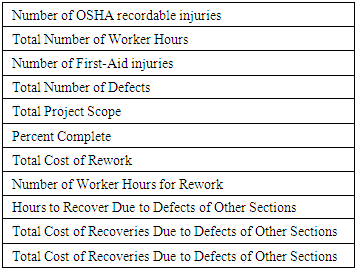 |
| |
|
Based on the previous research some relation need to be extracted [5]. In order to calculate the relation for INJ1, the rate of OSHA recordable injuries per total working hour should be calculated. Since INJ1 is calculated for 200,000 worker-hours, the rate is multiplied by 200,000. On the other hand, INJ2 represents the first-aid injuries rate per 200,000 worker-hours. INJ1 and INJ2 are calculated for gathered information and it is shown in Table 2.Table 2. INJ1 and INJ2 for gathered data
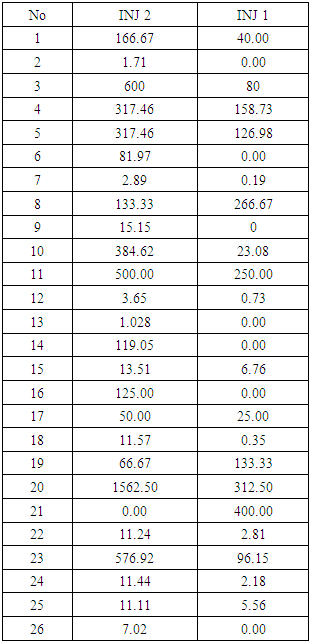 |
| |
|
Other series of questions were designed to investigate the project quality based on Q1 to Q6. The calculated values of these parameters are presented in the Table 3.Table 3. Calculated parameters
 |
| |
|
The hypothesis considered in this projects are shown in the Table 4.Table 4. Hypothesis
 |
| |
|
4. Empirical Data and Analyses
In the previous section, the required information was explained and gathered. After that simple linear regressions were applied on combinations of distinct metrics. First of all, the relation between recorded injuries, i.e. INJ1, and the working hours related to the rework, i.e. Q5, is investigated. As it can be seen in the following diagram, there is a positive relation between these two metrics, and INJ1 is linearly increased by increasing the rework-hour, which means that the null hypothesis is rejected. On the other hand, this figure shows that injuries rate can be seriously increased by reducing rework-hours. By comparing our figure with the results of Wanberg et al., it can be seen that the rate of injuries in our country is more than them, as in their work [5], for each 10 billion dollars’ project, the rate of injury is only one. However, in our research, figure 1, for each two thousand, the injury rate is 200. It should be noted that there are some points in the figures which are far from other points and the main distribution. The reason is that we collected data from various projects with different size and budgets. Due to this, a few high budget projects are far from other projects. | Figure 1. The relation between INJ1 and Q5 |
Now, we are going to investigate the relation between INJ1 and Q6. The strong relation between them and its comparison with the Wanberg et al. is shown in Fig. 2. As it can be seen, the rate of recordable injuries based on OSHA is increased in both figures. 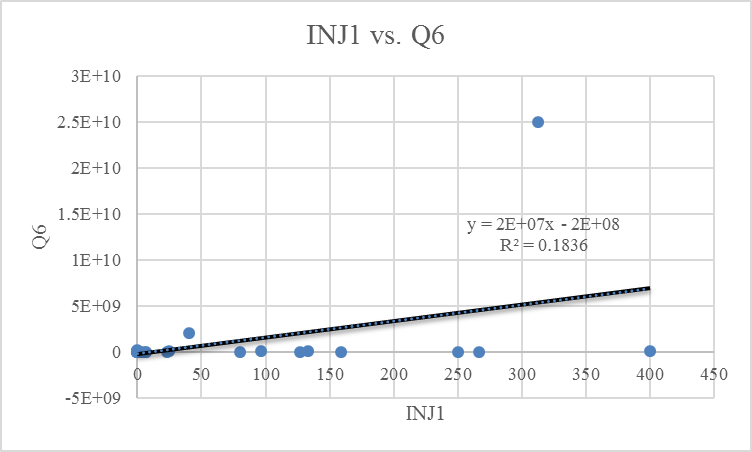 | Figure 2. The relation between INJ1 and Q6 |
Next, the positive relation between INJ2 and Q1 is shown in Fig 3. This represents first-aid injuries is growing, by increasing the number of faults in the project. That means the null hypothesis is rejected.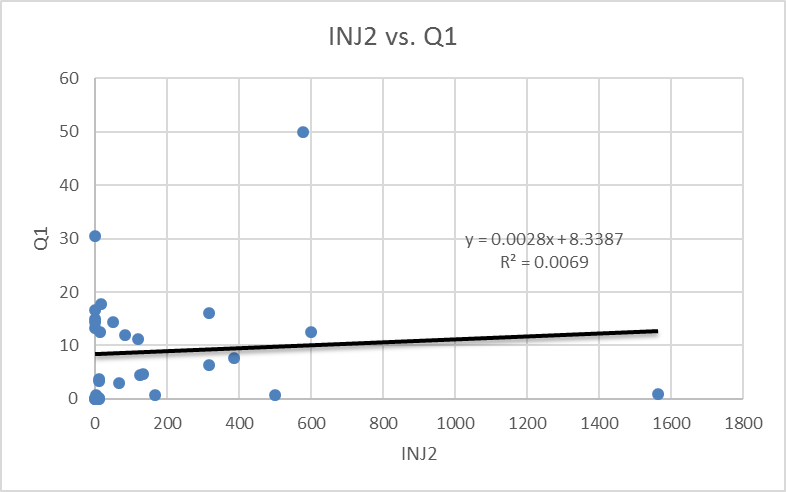 | Figure 3. The relation between INJ2 and Q1 |
The relation between INJ2 and Q2 is shown in the Fig. 4, which is almost the same as relation between INJ1 and Q2. It represents that as the number of defects are increased, more first-aid injuries are happened, which again means the rejection of null hypothesis. | Figure 4. The relation between INJ2 and Q2 |
In the next part, results and relations for foundation is described. First of all, the relation between INJ1 and Q5 for foundation is investigated, and the result is presented in the Fig. 5. This figure shows the positive relation between these two parameters. | Figure 5. The relation between INJ1 and Q5 for foundation |
The Fig. 6 shows the relation between INJ2 and Q1 for foundation. This figure also shows that Q1 is increased by increasing INJ2. Besides, the relation between INJ2 and Q2 based on data gathered for foundation is shown in the Fig. 7. the positive slope of the line in this figure indicates that increasing one result in having more value for other.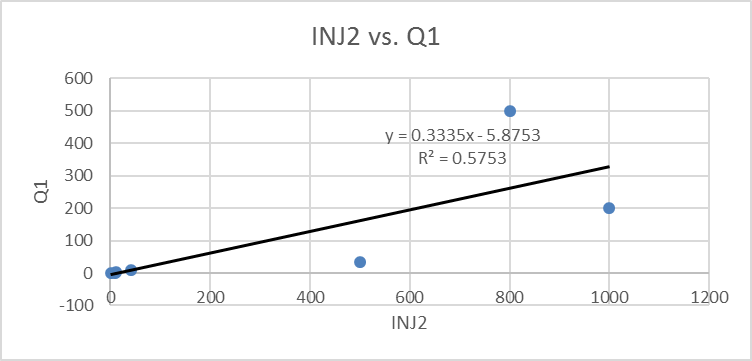 | Figure 6. The relation between INJ2 and Q1 for foundation |
 | Figure 7. The relation between INJ2 and Q2 for foundation |
The mentioned experiments and study can also be extended on construction projects in other countries, since the injuries are very frequent in every construction projects around the world. Therefore, the method used in this paper, can be used to analyse the relationship between injuries and quality in construction projects of other countries.
5. Conclusions
Safety is a significant factor in completing a project successfully. However, some factors influence safety such as the amount of rework. Whenever a fault happened in any part of the construction, it is not possible to ignore the fault and whenever it is decided to fix it, this effect other parts. In this work, the effect of performing reworks on the construction safety was empirically examined. Moreover, the effect of repairing damaged parts on the healthy sections is investigated. It was shown in this work that by increasing the rework rate, OSHA injuries is directly increased. In addition, it results in increasing first aid injuries. Moreover, it was shown that rate of increasing in Iran is more than the base paper’s country. Results show that the amount of injuries in one billion Toman in Iran is 200 units more than the country of the base paper. Moreover, first aid injuries in Iran is increased more than a base paper, and more reworks results in more first aid injuries. Therefore, to have a safer project, less rework should be done. Furthermore, the same investigation was done by considering foundation information. It also showed the positive relations between rework in foundation and rate of injuries. To conclude, performing reworks can lead to damaging completed parts of the project either in foundation or other parts, and this results in increasing the rate of OSHA and first aid injuries, cost and delay of the project. Therefore, the rate of rework in foundation and other parts should be minimized, to have safer project.
References
| [1] | Sgourou, E., Katsakiori, P., Goutsos, S., Manatakis, E., 2010, A continuous behavior-based safety strategy for persistent safety improvement in construction industry, Automation in Construction, 34, 101-107. |
| [2] | Sgourou E., Katsakiori P., Goutsos S., Manatakis E., 2010, “Assessment of selected safety performance evaluation methods in regards to their conceptual, methodological and practical characteristics,” Safety Science, 48(8), 1019-1025. |
| [3] | Hsu, I.Y., Su, T.S., Kao, C.S., Shu, Y.L., Lin, P.R., Tseng, J.M., 2012, Analysis of business safety performance by structural equation models,” Safety Science, 50(1), 1-11. |
| [4] | Gurcanli, G.E., Mungen, U., 2009, An occupational safety risk analysis method at construction sites using fuzzy sets,” International Journal of Industrial Ergonomics, 39(2), 371-387. |
| [5] | Wanberg J., Harper C., Hallowell M.R., Rajendran S., 2013, Relationship between Construction Safety and Quality Performance, ASCE Journal of Construction Engineering and Management, 139(10). |
| [6] | Wu X., Liu Q., Zhang L., Skibniewski M.J., Wang Y., 2015, Prospective safety performance evaluation on construction sites, Accident Analysis and Prevention, 78, 58-72. |
| [7] | Kamsu-Foguem B., Abanda F.H., 2015, Experience modeling with graphs encoded knowledge for construction industry, Computers in Industry, 70, 79-88. |
| [8] | Dyreborg J., Lipscomb H.J., and et al., 2015, Safety Interventions for the Prevention of Accidents in the Work Place: A Systematic Review, The Campbell Collaboration. |










 Abstract
Abstract Reference
Reference Full-Text PDF
Full-Text PDF Full-text HTML
Full-text HTML


